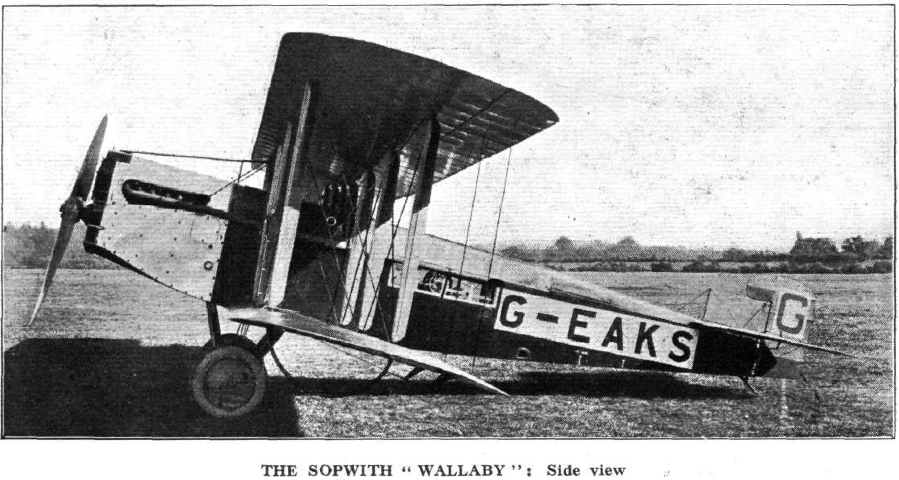 Vickers Vimy IV G-EAOU (dubbed “God ‘Elp All Of Us“) – Adelaide Airport, South Australia. Source: Aces Flying High
Vickers Vimy IV G-EAOU (dubbed “God ‘Elp All Of Us“) – Adelaide Airport, South Australia. Source: Aces Flying High
On 19 March 1919 Australian Prime Minister Billy Hughes announced a competition for the first Australian aviators to fly from England to Australia within 30 days with a prize of £10 000.
The rules of the air race stipulated that:
The crew members must be Australian,
the aircraft built in the British Empire,
the flight be completed within 30 days and before 31 December 1920,
the flight depart from Hounslow Heath Aerodrome (landplanes) or RNAS Calshot (seaplanes and flying boats) and the flight arrive in the region of Darwin.
The winner…
Vickers Vimy (G-EAOU)

Vickers entered a converted Vimy bomber G-EAOU (the registration being whimsically said to stand for “God ‘elp all of us”), crewed by Captain Ross Macpherson Smith with his brother Lieutenant Keith Macpherson Smith as co-pilot and mechanics Sergeant W.H. (Wally) Shiers and J.M. (Jim) Bennett. The Vimy left Hounslow Heath at 8.30 am on 12 November 1919.
It flew via Lyon, Rome, Cairo, Damascus, Basra, Karachi, Delhi, Calcutta, Akyab, Rangoon racecourse, Singora (Songkhla) (in Siam unscheduled in heavy rain), Singapore, Batavia and Surabaya where the aircraft was bogged and had to make use of a temporary airstrip made from bamboo mats, reaching Darwin at 4.10pm on 10 December 1919.
The flight distance was estimated as 17,911 kilometres (11,123 mi) and total flying time was 135 hours 55 minutes (131.8 km/h or 81.9 mph). The prize money was shared between the Smith brothers and the two mechanics. The Smith brothers each received a knighthood for this exploit, and the company presented their aircraft to the Australian government.
Runner up?
Airco DH.9:

On 8 January 1920, Airco DH.9 (G-EAQM), piloted by Lieutenant Ray Parer, with co-pilot Lieutenant John C. McIntosh, took off from Hounslow Heath.
The aircraft completed the flight, the first by a single-engine machine, in an epic 206 days later on 2 August 1920, earning Parer the sobriquet “Battling Ray”. Although outside the time limit, the crew was awarded a consolation prize of £A1,000, second only to the Vimy. The DH.9 has been restored and placed on display at the Australian War Memorial at Canberra.
The story is detailed in the book Flight and Adventures of Parer and McIntosh written by Emily Charnwood and first published in 1921. The machine is labelled PD after its sponsor, millionaire Peter Dawson, a whisky manufacturer, who financed the purchase of the machine and much of the journey. Ray Parer later took part in a similar journey, the MacRobertson Trophy Air Race in 1934
They also ran…
Sopwith Wallaby:

At 11.44 a.m. on 21 October 1919, Captain George Campbell Matthews AFC as pilot, and Sergeant Thomas D. Kay as mechanic, took off from Hounslow Heath Aerodrome in a Sopwith Wallaby (G-EAKS).
Bad weather caused delays at Cologne and Vienna, then they were imprisoned as suspected Bolsheviks in Yugoslavia, with further delays due to snow at Belgrade. A cracked engine cylinder at Constantinople, and bad weather at Aleppo caused more delays. Finally, on 17 April 1920, the Wallaby crashed on landing at Grokgak, on Bali. Matthews was slightly injured.
Blackburn Kangaroo:

A team with a Blackburn Kangaroo (G-EAOW) had selected as navigator the Australian aviator Charles Kingsford Smith. Smith withdrew from the contest, and Captain Hubert Wilkins MC and bar took his place. On 21 November 1919, the Kangaroo took off from Hounslow Heath, piloted by Lieutenant V. Rendle with Captain Wilkins, Lieutenant D.R. Williams and Lieutenant Garnsey St. C. Potts as crew.
Problems were experienced with the engines, and the plane was forced down over France. Repairs were made and the flight continued, still with engine problems. On 8 December 1919, the aircraft crash-landed at Suda Bay, Crete, ending up against the fence of a mental hospital. The crew escaped without injury.
Alliance P.2:

On 13 November 1919, Lieutenant Roger M. Douglas, MC DCM and Lieutenant J.S.L. Ross took off from Hounslow Heath in an Alliance P.2 Seabird (G-EAOX) named ‘Endeavour’. It crashed in an orchard in Surbiton; Ross was killed outright, and Douglas died soon after of his injuries.
Martinsyde Type A:
 The start from Hounslow of the Martinsyde aircraft on December 5th, 1919 Source
The start from Hounslow of the Martinsyde aircraft on December 5th, 1919 Source
On 5 December 1919, Captain Cedric E. Howell DFC DSO and Lieutenant George Henry Fraser left London in a Martinsyde Type A Mk.I (G-EAMR) aircraft. On 9 December, the aircraft disappeared near Corfu. The wreckage and Howell’s body were found offshore, but Fraser’s body was never found
Caudron G4:
 Prior to departure for Australia. Apparently a ‘vulture’ flying into an engine was the last mechanical breakdown before abandoning their attempts.
Prior to departure for Australia. Apparently a ‘vulture’ flying into an engine was the last mechanical breakdown before abandoning their attempts.
French pilot Etienne Poulet and his mechanic Jean Benoist also attempted to fly to Australia at the same time, despite being ineligible for the competition. They left Paris on 14 October 1919 in a Caudron G4. The Vimy overtook Poulet in Burma on 29 November 1919. Poulet decided to abandon his attempt in Thailand around 12 December 1919.
Related stories
1919 England to Australia GreatAir Race: Message to HMAS Sydney: ‘Very glad to see you…’ Ross Smith and the Great Air Race, 1919
1919 England to Australia Great Air Race: Why Smithy couldn’t fly the Kangaroo
Sources:
Wikipedia 1919 England to Australia flight
SLSA digital collections: Air race competitors